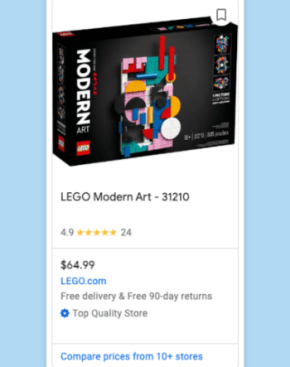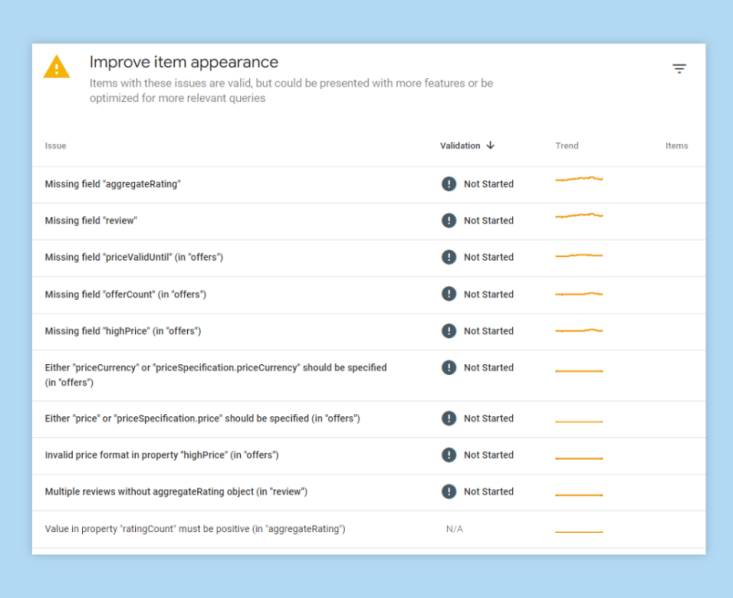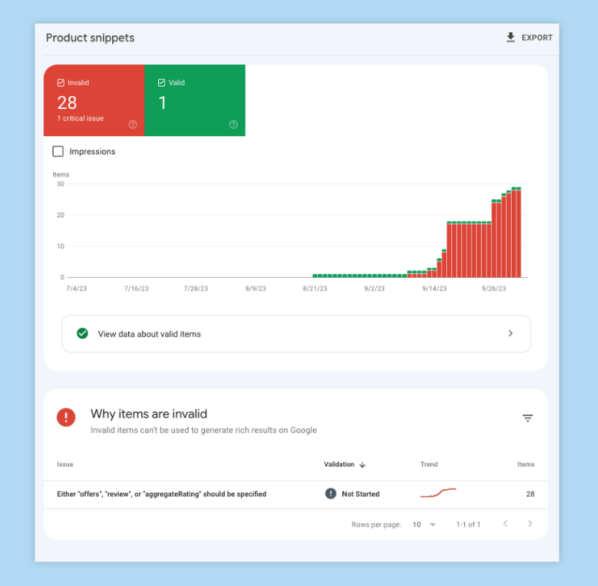2023 has been quite the year with all the changes happening at Google. Between core algorithm updates, changes to Video rich results, and FAQ & How-to rich results being deprecated, there is a lot to process. That said, there has still been a lot of positive movement around one of the ‘evergreen’ rich results – Product rich results.
Google has continued to expand the properties around Product structured data, enabled Merchant Listing experiences through structured data, and provided more opportunities for web publishers to enhance their Product rich results with more information like return and shipping details.
Additionally, Google can now award Product rich results even without structured data. This, in theory, might sound great. But the problem is that even Google can get it wrong sometimes.
So what do we do when our Product rich results aren’t showing up as expected? Let’s jump in.
Different Types of Product Rich Results You Can Achieve
Firstly, it is important to distinguish the types of Product rich results available as this might modify how you tackle correcting the enhanced search result.
When reviewing website performance on Google Search Console, you’ll see three different types of Product search appearances in your performance report:
- Product results
- Product snippets
- Merchant listings

Product Results = Product Snippets + Merchant listings
Product results are an all-encompassing view of performance around your Product rich results. This can include Product rich results awarded directly by Google, Product rich results awarded through the use of structured data, and Merchant listings results.
Product Snippets
Product snippets are a type of Product rich result that are awarded through structured data. They typically include information such as ratings, reviews, prices and stock availability.

Example of a Product Snippet
Merchant Listings
Merchant listings, also known as merchant listing experiences, are another type of Product rich result that you can achieve through structured data or through Google Merchant Center. They tend to have more detailed information than product snippets and can show up in the Popular Products, Shopping Knowledge Panel and Google images section of the SERP.

Example of a Merchant Listing Experience
How To Determine If Your Product Rich Result Isn’t Showing Up Correctly
The answer is simple, but often overlooked industry-wide.
The easiest way to determine if your Product results are not showing up as expected is to simply find them on the search engine results page (SERP). This should provide you with all the details you may need to determine if the rich result achieved is aligned with your product details.
So, is that it? Assuming you’ve reviewed your Product rich results on the SERP, everything looks good and your traffic is increasing, then yes, it’s as simple as that!
But, let’s say your Product rich result is not showing up the way you want and you want to correct those issues. In that case, here are some of the common Product rich result pitfalls and what you can do to fix them.
Common Product Rich Results Mistakes
1. Not utilizing structured data
Google has the ability to grant Product rich results on your behalf. However, giving away control of your search appearance means you might not always get your desired display.
In our experience, we’ve seen Google award Product results to blog pages based on a price stated in a headline, or target an incorrect price on a Product page with different prices that varied depending on membership standing.
Adding Product markup to your pages is the first step to regaining control over the information you want presented on your Product rich result in the SERP. This means that you’ll need to add Product structured data to all your product detail pages and manage the markup on an ongoing basis, which can be tedious if done manually. At Schema App, our Highlighter tool allows SEO teams to automatically create and deploy Schema Markup dynamically to thousands of pages at once. If you struggle to implement and manage your Product markup at scale, we can help.
As previously mentioned, Google can award your pages the merchant listing experience based on the data in your Google Merchant Center feed. If you are not relying on structured data for your Product rich results, you should ensure that the product information on your Google Merchant Center feed is accurate and up-to-date.
2. Not utilizing the recommended Schema.org Product properties
Do you have an aggregate rating for your Product that is not showing up alongside your pricing information? Are you hoping to show off some of your shipping or return details?
All this comes down to ensuring you’re incorporating the recommended properties from Google’s Product feature guide. In the guide, Google lists all the result enhancements that you can achieve for your Product rich results by adding the relevant content and recommended properties in your markup.
For example: If you want to highlight your offer of free shipping with your product, you can include the shippingDetails property in your product markup. Your Product rich result will then showcase the free shipping offer.

It is important to follow each of the examples to determine which result enhancement is best suited for your pages and how you want to stand out in search.
3. Highlighting incorrect information
As a user who makes informed decisions based on details provided on the SERP, it can be disheartening to see the information presented on the rich result differ from the information displayed on the product detail page.
Examples of this could include indicating an incorrect price, incorrect aggregate review values or counts, and stating a product is in stock when it actually isn’t. This can easily happen when you implement structured data manually on your site and make updates to your content without updating the structured data accordingly. More commonly known as Schema Drift, this mistake can impact the accuracy of the information shown in your Product rich results and reduce your rich result eligibility.
These are challenges that need to be addressed within the structured data. If you notice your Product rich result displaying incorrect information for any of the required and recommended properties, it is important to revisit your Schema Markup to avoid any possible manual action levied against your site for presenting incorrect information.
The Schema App Highlighter can help you overcome the issue of schema drift by creating Schema Markup templates for similar page sets. Your Schema Markup will update dynamically based on the content on the page. Contact us to learn more.
4. Not correcting errors in GSC
If there is an error with your structured data, you’ll likely see it in the enhancement report on Google Search Console.
The product snippet and merchant listing enhancement reports in Google Search Console will show you:
- Valid items that are eligible for product rich results
- Valid items that could be improved in appearance
- Invalid items that are not eligible for rich results and the reason for invalidity
Improve item appearances
Items that show up in this category are valid items that could be presented with more features if more recommended properties and content were included.

This can be viewed as an opportunity to ensure you’re calling out those properties where content permits. It is quite common, however, for Products to have a list of “issues” in this section because most product pages will rarely include all the recommended properties and content for those properties.
Invalid items
Items that show up in this category are invalid items that have issues preventing Google from using your structured data. This will render your page ineligible for the rich result until the issue is rectified.

If you see any invalid items on your enhancement report, you need to revisit the product markup on those pages and ensure your markup, at the very least, includes the product’s name, and either a review of the product, an aggregate rating, or a price.
5. Not being more semantic with your product markup
Search engines are shifting to semantic search and it is important for your organization to include as many details in your Product markup as possible and be more semantic with your Schema Markup.
You can be more semantic with your Product markup by linking the entities on your page to other entities on your site. For example, you can link your Brand to your Product markup under the brand property. This tells search engines that the product on this page is maintained or associated with your brand.
You can also be more semantic by linking entities on your page to external authoritative knowledge bases like Wikipedia or Wikidata. For example, if you offer free shipping within the US, you can link the USA wikidata page using the sameAs property to the DefinedRegion of the shippingDestination.

That way, search engines have a clear understanding of which destination you offer free shipping to.
Linking the entities on your site and beyond can help you develop a knowledge graph and provide search engines with more contextual information about your organization. It can also future-proof your organization for a more conversational style of search through AI chatbots like Google’s Search Generative Experience, ChatGPT or even your own chatbot.
Consider how users might engage with a chatbot where they request a product that has a certain pattern, free shipping in the United States, and is a suitable gift for a female – these can all be informed through Schema Markup!
6. Not monitoring performance
You might’ve reviewed the mistakes we covered above and not made any of them. But that does not guarantee improved performance with your Product rich result.
E-commerce is a competitive space and your customers’ purchasing decisions could easily be swayed – both positively and negatively – based on the enhanced results provided in the SERP.
If you find your click-through rate declining when a Product rich result is awarded, you need to analyze the factors that might be influencing performance and run experiments to determine whether it needs to be corrected.
Example 1: If your product listing page contains poor reviews and you’ve included aggregate rating markup on that page, your Product rich result is very likely to showcase these poor ratings and reviews. Buyers could see the rating on the SERP and choose not to explore your product further, thus reducing clicks and click-through rate to your page. In this situation, you can consider removing the aggregate rating markup to see if your click-through rates improve after.
Example 2: If your product is expensive and you have a high price tag on your Product rich result, at first glance you might see your traffic decline. But you should also consider whether the decline is impacting your website conversion rate. Having users qualify themselves might not be a bad thing as long as it doesn’t affect sales. In fact, it might better align with user intent and lead to higher-quality traffic for your site.
At the end of the day, your rich result performance should align with your desired outcomes. If it isn’t aligning with your organization’s goals, you should consider enhancing it with different information or maybe even targeting a completely different rich result as a whole.
Scalability of Product Rich Results
Despite all of Google’s recent rich result changes, Product continues to be an exciting rich result to pursue. However, you should consistently monitor how your products are showing up in search to fully maximize your performance through this rich result.
Many of the recommendations we’ve provided can be easily tackled on a page-by-page basis. But if you’re having difficulty finding a scalable solution to help you drive performance through your Product rich results, Schema App can help.
Get in touch with us today to learn more!

